Peter MALONE
Saturday, 18 September 2021 19:42
Those Redheads from Seattle

THOSE REDHEADS FROM SEATTLE
US, 1952, 90 minutes, Colour.
Rhonda Flemyng, Agnes Moorhead, Gene Barry, Guy Mitchell, Teresa Brewer.
Directed by Lewis R.Foster.
Those Redheads From Seattle is an entertaining musical western - with an Alaskan setting. It is a vehicle for Gene Barry (in his musical days) and Guy Mitchell. They appeared to good effect in Red Garters. The film is also a vehicle for the belting-it-out singer Teresa Brewer. Rhonda Fleming is the heroine. Agnes Moorehead the fiery mother of the redheads.
The film is colourful, the songs lively - and it was originally shot in 3-D.
1. An entertaining frontier musical? The style of 150s films?
2. 3-D processes? Colour photography? Locations and atmosphere?
3. The musical score, the songs? Guy Mitchell and Teresa Brewer?
4. The familiar frontier story? The focus on Johnny Kisco? The Klondyke Club? The rough life? The attack by the newspaper editor? His death? His wife and daughters arriving? The clashes, suspicions, Kisco helping? The tracking of the murderer? The happy ending? Entertaining familiar material?
5. Johnny Kisco, the Klondyke Club and its style, the attacks by Vance Edmonds, his murder? Kisco's attraction towards Kathie? The reaction of the family? His help, Kathie's suspicions, her forcing Kisco to sell the club? The pursuit of the murderer? The resolution of the truth - happy ending and marriage?
6. The Edmonds family? The background from Seattle, the trip to the north, their hopes, the death of the father? Mrs. Edmonds and her vigour, managing the family? Pat and her singing? Connie and Nell? Kathie and her fiery style, the attack on Cisco, the suspicions, the taking over of the paper, forcing him out, the truth - and the happy resolution?
7. Joe Keenan and his song and dance style? Help in Alaska?
8. The atmosphere of the town, the paper, the ordinary citizens, the Klondike club and its clientele, songs and dances?
9. A slight but entertaining picture of the Alaskan frontier? Those Redheads from Seattle is a pleasant musical western with a period setting and the main action taking place in Alaska. It is a pleasant '50s-style musical with Paramount stars of the time and singers Teresa Brewer and Guy Mitchell. Rhonda Fleming is an attractive heroine, Gene Barry a tough hero and Agnes Moorhead is herself as the fussing mother. The film is attractive and colourful, Guy Mitchell and Teresa Brewer have elaborate staged numbers and there is action and romance including a shoot out in the snow. Direction is by Lewis R. Foster who made many action films (many with Rhonda Fleming) in the 150s at Paramount.
Published in Movie Reviews
Published in
Movie Reviews
Tagged under
Saturday, 18 September 2021 19:42
Something Evil
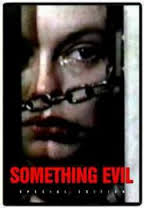
SOMETHING EVIL
US, 1972, 73 minutes, Colour.
Sandy Dennis, Darren Mc Gavin, Ralph Bellamy, Jeff Corey, Johnny Whitaker, John Rubinstein, Margaret Avery.
Directed by Steven Spielberg.
Asking for the director of Something Evil would be a very good Trivial Pursuit question. In fact, Steven Spielberg had made a number of short films during the 1960s and directed Joan Crawford in an episode of Night Gallery in 1969. He also directed episodes from Marcus Welby, The Name of the Game, The Psychiatrist, Colombo and Owen Marshall. His first television film was the celebrated Duel. Something Evil came after. This was three years before Jaws.
The film is a simple story of the haunted house variety, like The Amityville Horror. Darren McGavin? and Sandy Dennis portray a couple who by a house which is allegedly possessed by the Devil. The expected consequences occur – although Spielberg, with his flair for direction and camerawork, makes this a slightly above average variation on this theme.
1. Was this a succesful telemovie? Comment on the use of television techniques, close-ups. Comment on the television style.
2. The portrayal of the house, the personalities, the editing?
3. How well did the film treat its theme? The theme of the occult and possession for home viewing for tele-viewers? Did this detract from the theme?
4. How successful was the impact of the opening of the film? The mystery, the occult, the death? How did this effect audience response and make them ready for the rest of the film?
5. How well did the film communicate the mystery of something evil? The devil, superstition? The evil as shown, the devices, the medallion, the eyes of the devil on the commercial? What is audience response to this kind of mystery and evil? How welldid the film utilise the response?
6. The solution was exorcism by love. As explained by Harry Lincoln? As plausable? The effect on the end?
7. How important was the house in the film? The initial seeing of it by the audience, by the Wardens? The design of the house, the barn? The strange design and the medallion? The visualising of the strange happenings within the house?
8. How ordinary were the Wardens? Our initial seeing them, Marjorie’s painting, the desire to buy the house, their New York background? Marjorie’s artistic work and its effect? Paul and his work in advertising? The children?
9. How interesting was the character of Marjorie as portrayed by Sandy Dennis? The visualising of her moods, the changes in her life and attitudes? Her love for Paul, her children? Her turning brutal against Stevie? Her fears and loneliness? Her not understanding what was happening? The suicide attempt parallel to the opentng of the film? The exorcism by love? Was she a credible character, that audiences could identify with? As woman, wife and mother?
10. Was Paul an interesting character? Typical advertising man, husband? His compassion yet his not understanding? The quality of the relationship of husband and wife? His involvement with his work? His role In the resolution of the film?
11. The portrayals of the children? The gradual possession of Stevie? Whose responsibility was this? Clash of son and mother? The dawning on the audience that the child was possessed? The dramatics in the room? The exorcism by love?
12. What did the character of Gehrmann add to the film? His explanation of past evil?
13. The character of Harry Lincoln? His explanations of the occult? His comforting of Marjorie, the horror of his death? The importance of his nephew in the film?
14. How did the world of advertising and the TV commercial contrast with something evil? The satire in the work, in the commercial and its filming? And yet the eeriness of the eyes in the film?
15. How satisfying was the resolution?
16. Why do films about the occult appeal to modern audiences?'Was this an a successful example?
Published in Movie Reviews
Published in
Movie Reviews
Tagged under
Saturday, 18 September 2021 19:42
Somebody Loves Me
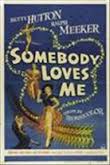
SOMEBODY LOVES ME
US, 1952, 97 minutes, Colour.
Betty Hutton, Ralph Meeker, Robert Keith, Adele Jergens, Jack Benny.
Directed by Ivan Brecher.
Somebody Loves Me is the biography of singer Blossom Seeley. She was portrayed by Betty Hutton, often a raucous singer but subdued here in this biography.
Betty Hutton had made an impact with The Perils of Pauline, the story of the silent screen actress who was always in adventures. She had a good role as Annie Oakley in Annie Get Your Gun and appeared in the same year, 1950, with Fred Astaire in Let’s Dance. She was also the star of Cecil B. de Mille’s The Greatest Show on Earth. However, Somebody Loves Me was to be her last major film. She made a few more and appeared in television (dying at the age of eighty-seven in 2007).
Ralph Meeker plays her husband Benny Fields. The film is as was the case in most of these film biographies, a rather sanitised version of the life of its central characters. However, it presents images of show business in the first half of the 20th century and features Blossom Seeley and her songs.
Director Ivan Brecher was a writer, who contributed to some of the Marx Brothers films in the 1930s.
1. Was this an interesting biography, good theatre story, good musical?
2. A musical of the fifties, the staging of the songs, the representing of San Francisco at the turn of the century, the re-creation of Broadway at its height? Colour, costumes, musical styles?
3. How much did the success of the film depend on Betty Hutton, her verve and her style? Her particular style and movement when singing? The presentation of the character of Blossom Sealy and her success and style?
4. The contrast with Ralph Meeker, his musical style as Benny Fields? When he was playing second to Blossom, when he developed his own style? The particular attitudes of the early part of the century for a male musical singer?
5. The impact of San Francisco in 1906, Blossom and her energy and hopes, the humorous use of the earthquake? The build-up of her career, the importance of the monkey on the singer's dress and people laughing at her? Chance success for Blossom? Was it credible that she should have made such an impact at the beginning? The film's collage presentation of ten years of growing success? The momentum of her career?
6. The re-creation of the world of burlesque and vaudeville, backstage story, the audiences, the staging of the comedy and the songs, the low?class theatres, Broadway itself? Audience response to this popular kind of theatre? Nostalgia and its passing?
7. How well did Betty Hutton portray the character of Blossoms her origins, success and wealth, her relationship with her agent, dependence on her maid and her wisecracks, her coping with success? Her finding of Benny, her loving him and yet being blind to him? How convincing was she in her hostility towards him, her marrying him? Their clashes and the effect on her? Her disbelief at his going, her pulling out of the Ziegfeld Follies? Her joy at his return, her coaching and pushing him? Her deal for his success? Were these activities credible? What was going on in her?
8. The contrast with Benny? A suave self?opiniated character, his push, his relationship with his friends and their mistake in upstaging Blossom? His staying on, using her? His callous attitude in marrying her? The fact that everybody could see it except Blossom? The impact of his marriage for success?
9. How convincing was his discovery that he was ‘Mr. Sealy' and that he loved Blossom? People talking, using his wife’s name? How convincing was his leaving of her, his being humiliated in San Francisco? The agent explaining that he should go back, his decision to go and her persuading him to be a musical success?
10. The transition in his personality with the help of Blossom, his finding his own musical style? His disillusionment to discover the truth on his opening night, his defiance and his success? His recognition of his relationship with Blossom? Their final singing together? How convincing was this human backstage story?
11. The presentation of the various songs, in San Francisco, at rehearsals, the Broadway numbers to illustrate Blossom's versatility, her Ziegfeld number? the title song? The use of the title song and its meaning, especially at the end?
12. How conventional was the material of this film? How well was the conventional material presented?
Published in Movie Reviews
Published in
Movie Reviews
Tagged under
Saturday, 18 September 2021 19:42
Some of My Best Friends Are
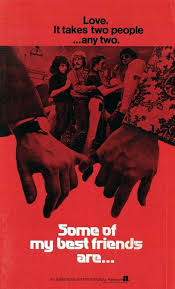
SOME OF MY BEST FRIENDS ARE
US, 1971, 110 minutes, Colour.
Fannie Flagg, Rue Mc Clanahan, Carleton Carpenter, Calvin Culver, Candy Darling, Nick De Noia, Gil Gerard, Dick O’Neill?, Sylvia Syms
Directed by Mervyn Nelson.
Some of My Best Friends Are … is a film about homosexuals in Manhattan’s Greenwich Village on Christmas Eve 1971. The focus of attention and the location is The Blue Jay bar. It is not so long since the Stonewall protest and the film offers an opportunity to reflect on what homosexuals experienced at this time of discrimination and changing legislation.
Some of the cast went on to other films and television programs including Rue Mc Clanahan and Gil Gerard. Carleton Carpenter, who was a young star at MGM in the 1950s (I Love Melvin and singing ‘Abba Dabba Honeymoon) with Debbie Reynolds in Two Weeks With Love is Miss Untouchable. Warhol actress Candy Darling also appears as does gay icon Calvin Culver.
William Friedkin’s The Boys in the Band, from the play by Mart Crowley, had appeared the year before, a much more complex film and with a bigger budget. However, these films are reminders of changing mores and attitudes in the 1960s and 70s.
1. The implications in the tone of the title? Especially in view of the theme of homosexuality? Wbat were your initial reactions to this title?
2. How did the film communicate the atmosphere of the Blue Jay on Christmas day? How important that this was the time for the setting of the film? Why?
3. Did the setting seem real or did it sewm artificial in order to get as many types as possible into the film? Was this important for the meaning of the film?
4. What were your impressions of the bar itself? As a congenial place? As ugly? As a place where people were frightened? As a place for enjoyment? How did the presentation of the staff help this? The manager, the straight bartender, the motherly woman? How important was this for the human setting for the portrait of homosexuals?
5. Was the film well plotted? The situations and failings in the bar? The manager and the arrangements with the police? the ebb and flow of people in the bar during the evening?
6. How important were the types of homosexuals presented in the film? As persons? Their relationships? their self-image? Their worries?
i) The waiter: Sherry and his flirting on the phone, his preening himself, his working in the bar, the reaction of the man who came thinking he was a girl? the meaning of his life and the whole emphasis on trying to relate to people too?
ii) Howard Wilkins: as a religous person, his organ playing, his relating to his brothers, the confession, the needing of sympathy? How sympathetic a character was he? How real? In his being humiliated during the evening? In his relating personally to Harry? How important was he for the film to give it a tone of ordinariness?
iii) Barrett Hartman: the homosexuat as a married man with personal respect? His relationship to Michelle? The importance of the flashback to the skiing, the nature of his fight with Michelle and his revelation of the emotional tangles of a homosexual? With the background of the marriage? Does this seem a real case? What audience response emotionally does it draw?
(iv) Karen/Harry, as a pathetic figure in drag? When did you realize the this was a man? The image that he put across when he was in drag? The toughness? The humiliation of his being exposed? As a pathetic figure? How real was the insight into this type of character?
v) Terry: the commercial artist, as a gentle kind of person, the flashbacks to him in his work? Why did he relate to Scott? The nature of his love, as a tender person? The humiliation of his mother’s interventiion? the effect on him?
vi) Scott: as an airline pilot, as seemingly normal, as needing this kind of relationship? Was he a strong character or not?
vii) The Italian actor: his stud reputation on the screen, his impotency in his relationships with women, his tough image and yet his pathetic self-hatred, his welcoming of the boy from Nebraska? A genuine character? Could he over change and better his image of himself?
viii) The solitary person: the aloof style, the loneliness and yet the putting over of pompous superiority?
7. Leta: The blonde? Her role in the film as contrasting with homosexuals? As an ugly woman from their point of view? with Scott? Her taunts and threats?
8. What was the atmosphere of the film as time came for closing? As the police came in?
9. How sad and pathetic was the finale? Christmas Evening, the closing of the bar? The people going home? bruises and hurts that they were taking with them? Michelle at the table? the return of Hartman?
10. How typical were the people in this film? Did they evoke sympathy or antipathy? Why?
11. How well did the film raise the reality of homosexuality? Of the people who are homosexual and their emotional needs? Did the film have value from this point of view?
Published in Movie Reviews
Published in
Movie Reviews
Tagged under
Saturday, 18 September 2021 19:42
Some Kind of a Nut
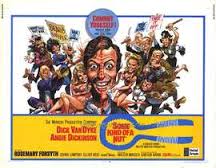
SOME KIND OF A NUT
US, 1969, 90 minutes,
Dick van Dyke, Angie Dickenson, Rosemary Forsyth, Zohra Lampert.
Directed by Garson Kanin.
An an attempt to make a topical comedy about anti-Establishment attitudes in the late sixties. A similar but more successful comedy was George Seaton's What's So Bad About Feeling Good?. It was about the anti-Establishment attitudes of the middle-aged.
Dick van Dyke is at home in this kind of comedy situation and does his best although many of the comic terms are forced. Angie Dickinson is quite attractive as his wife. The surprise is that the film was written and directed by Garson Kanin, who had written and directed films in the late thirties and early forties, like They Knew What They Wanted and Bachelor Mother. With his wife Ruth Gordon he had written many screen plays like Adam's Rib and Pat and Mike for Spencer Tracy and Katherine Hepburn. This screenplay seems a very slight effort and quite strained. However, it does reflect in some ways America in the late sixties.
1. The film received very bad revievs on its first release. Why? How well did it reflect America at the time, the middle-aged and their reactions to conformity and the possibility of some kind of revolt? How does it seem now?
2. The title and its American tone? The particularly American atmosphere of the film? Its stars?
3. The importance of technical style, split screen, the various distorted lens shots, the presentation of Fred's trip, the psychedelia, the alternation of Pamela and Rachael in Fred's imagination, the farcical aspects and the way they were presented? Adding to the film, distracting from it?
4. A glance at the United States in 1969 - fads, anti?Establishment tones? The symbol of the beard? How does this seem now?
5. The credits and the long opening sequence? What did it establish? The relationship of Fred and Pamela? Rachael’s presence? Marriage, sex, the behaviour of the police and their spying? Public offences? A situation for the growing of the beard? The success of the farcical aspects of comedy?
6. The contrast with the sobriety of the bank, Pamela and Fred seen at work? The contrast with Rachael? Fred's plans for divorce and re-marriage? The growing of the beard and the issue at the bank? The gallery of bank people as seen in their reaction?
7. The focus of the film on the beard - and Fred looking in the mirror, at the restaurant with Pamela imagining all kinds of beards? The ordinariness of it and the extraordinariness of the reactions? The reaction of the bank manager, the owner of the bank and all the interpretation of left-wing approaches? Rachael and her appreciation of Fred's self-assertion?
8. The trip and Pamela’s reaction, friends and their disgust? Their coming together and their attempting to shave him?
9. The advice that Fred took to cope with the situation, exercise, the Maharishi, the fads? The taxi driver?
10. The parody of demonstrations with the bank people demonstrating about the board and not using the bank?
11. The character of Rachael, Fred's swim with her after his crisis, the bond between them? Her driving a truck, giving him support, the future since he had changed so much?
12. The long chase sequence throughout the house - humorous, forced? The hospital sequence and Fred's release?
13. A happy ending? How successful a middleclass attempt at criticizing fads, Establishment primness, presuppositions?
Published in Movie Reviews
Published in
Movie Reviews
Tagged under
Saturday, 18 September 2021 19:42
Sombrero

SOMBRERO
US, 1953, 103 minutes, Colour.
Ricardo Montalban, Pier Angeli, Vittorio Gassman, Yvonne De Carlo, Cyd Charisse, Rick Jason, Nina Foch, Kurt Kasznar, Walter Hampden, Thomas Gomez.
Directed by Norman Foster.
Sombrero is an exotic concoction by MGM – and filmed in Mexico with exotic Mexican atmosphere. It is a romance story, with leading ladies and gallant men, falling in and out of love – with touches of jealousy.
Mexican actor Ricardo Montalban is at home in this role and his rival is played by Italian actor, Vittorio Gassman, who appeared in a number of American films at this time. Italian actress who also moved to Hollywood, Pier Angeli, is the leading lady but there are two exotic ladies in the background: Yvonne De Carlo and Cyd Charisse – who also gets the opportunity to dance.
An exotic matinee entertainment.
The film was co-written and directed by Norman Foster, an actor, producer and director. He made six of the Peter Lorre Mr Moto films in the 1930s as well as three Charlie Chan movies. From 1956 after directing two Davy Crockett films he worked in television.
1. How entertaining a film? How interesting? Its impact in the fifties and now?
2. Audience expectations of the film and their fulfilment?
3. The presentation of the stars, the colourful backgrounds, Mexico and its way of life, melodrama, romance and comedy?
4. How well did these ingredients blend? How credible the events? How plausible the characters? The novelettish overtones of their presentation? Did this detract from the impact of the film or not?
5. Pepe and his introduction to the film? The introduction to his world? The conventions of his talking to the audience?
6. The presentation of Mexico? The love and hatred, the village life style, Mexican ways, the modern Mexico, old Mexico and superstitions? Village rivalries and battles? The way of life in the city, cars and bullfights? How important was the Mexican flavour? As influencing the characters and the plot?
7. What kind of man was Pepe? A congenial conman? His relationship with Eufemia? Their meeting in the cemetery? Eufemia as a heroine? Her relationship with her father? Pepe’s tricking of the father with the cheese? Love and a feud? The Romeo and Juliet overtones of the solving of the feud? The battle of the fighting cocks? How enjoyable this romantic aspect of the film?
8. The melodrama of Ruben and Lola? The length to which Ruben went to meet Lola? Lola’s fear and imprisonment? The intense relationship with her brother? His superstition? The reason for his death in the bull-ring? The significance of Lola’s dance? Her freedom? The satisfactory happy ending?
9. Alejandro? The contrast of the rich classes with the poor? The nature of his illness and facing it? The discussion with Maria about the marriage and the heir? His marriage, his fidelity and infidelity? Maria and her self-sacrifice? The drama of his death? The melodramatic behaviour of his wide? Maria’s reconciliation with the father? How credible this story? How moving emotionally?
10. The contribution of the minor characters: Don Carlos, the priest?
11. What values are assumed and explored in this kind of popular entertainment?
Published in Movie Reviews
Published in
Movie Reviews
Tagged under
Saturday, 18 September 2021 19:42
Soft Beds, Hard Battles
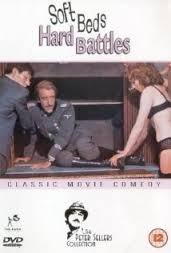
SOFT BEDS, HARD BATTLES
UK, 1974, 107 minutes, Colour.
Peter Sellers, Lila Kedrova, Curd Jurgens, Beatrice Romand, Thorley Walters, Timothy West.
Directed by Roy Boulting.
Soft Beds, Hard Battles is not as funny as audiences would hope for. While Peter Sellers plays six different roles, he does not dominate the film with any of the particular characters. These include a British major who actually hides away in a Parisian brothel, the madam played by Lila Kedrova. He also plays a Gestapo agent investigating. He is a French general of the Resistance. He also is the Japanese imperial prince who is targeted by the Resistance – and he is going to visit Hitler. Sellers also plays Hitler. Finally he is the French president.
The Boulting Brothers, Roy and George, had made strong vehicles for Peter Sellers in the 50s and 60s with I’m All Right Jack and Heavens Above. This time the vehicle is only moderate in its entertainment – and Sellers had fallen on hard times with his reputation and Blake Edwards was reviving his roles as Inspector Clouseau.
However, as a British comedy of the 70s and an opportunity to see Sellers doing his variety of impersonations, it is worth a look.
1, Was this a good comedy? How strong was the humour in situations and dialoguel, characterization? How weak a comedy was it? How dated does it seem? How entertaining was it?
2. The implications of the title with war as ugly and sex as humane? The presentation of old world attitudes crushed by war in the new world? How throughly was this followed through? How successfully?
3. Was the film meant to be taken seriously? Its full word about the nature of history and myth? Yet its realistic presentation of resistance motivation and the presuppositions in the audience that it demanded for a response to war and resistance? Did the film combine satisfactorily its serious tone and its comic tones?
4. How much did the film rely on Peter Sellers’ personality and his impersonations? Which were his most successful impersonations here? Which were less satisfactory? Why is Peter Sellers a good impersonator? What qualities does he bring to his characterizations?
5. The Madame? how interesting and real a character? How entertaining? How seriously involved in the resistance? The presentation of the brothel and its way of life and values? Its style?
6. Were the other characters in the film more than one dimensional? Why? The German girl? Marie Claude? The American girls? The Chaplain? The Nuns? Did it matter if the characters were not fully drawn?
7. What attitudes towards the French and Germans were evident in the film?
8, Was the film successful in its presentation of detail of decor and costume, of re-creation of Paris 1940, the details of the war and the time, the outwitting of the Germans?
9. What is the value of comedy going over its old material?
Published in Movie Reviews
Published in
Movie Reviews
Tagged under
Saturday, 18 September 2021 19:42
So Proudly We Hail/ 1943

SO PROUDLY WE HAIL
US, 1943, 126 minutes, Black and white.
Claudette Colbert, Paulette Goddard, Veronica Lake, Barbara Britton, George Reeves, Walter Abel, Sonny Tufts, John Litel.
Directed by Mark Sandrich.
So Proudly We Hail, with its lyrics from the American national anthem, is a morale-boosting film of World War Two. It is also a tribute to the women who served as nurses, especially in the Philippines. The film is not so much a war film as a portrait of people in war. The film focuses on a group of women under the leadership of Claudette Colbert who go to Hawaii for service. However, after the bombing of Pearl Harbour, they are transferred to the Philippines where they serve in the intensity of the attack by the Japanese. They have to abandon their post and take refuge on the island of Corregidor in Manila Bay. This is a film about the women returning to the United States and their memories of what they experienced during the war.
Claudette Colbert is very effective in the role of the leader but it was Paulette Goddard who got an Oscar nomination for her role as a nursing lieutenant. Veronica Lake has the chance to do some strong acting rather than just simply being sultry in thrillers. Hollywood and television Superman, George Reeves, also has a strong role.
The film offers a women’s point of view of war, something different from most of the war action films and the tributes. To that extent it is not such a jingoistic film as many of the others of this period.
The film was directed by Mark Sandrich who died not long after the release of the film at the age of forty-five. He had a promising career, especially with his direction of five of the Fred Astaire-Ginger? Rogers musicals of the 1930s. He also directed Holiday Inn which introduced Irving Berlin’s song, ‘White Christmas’.
1. The impact of this film in the forties during the war, the impact now, in retrospect?
2. The particularly American title, its morale, patriotism, propaganda? Did it signify the quality of the plot?
3. How did the film achieve a sense of realism and authenticity for the war? Identifying people, crises? Audience identific ation with the characters and their participation in the war, the patriotic sentiments, the effect of the war on them, human issues?
4. The picture of America in the 1940s, the background to the war, people leading ordinary lives, the detailed attention to this, reaction to the war, enlisting, training etc.? The necessary involvement of a whole nation?
5. How well did the fi1m build up a sense of patriotism, communicate it? Was it jingoistic or balanced? The patriotism as represented in each of the major characters, their coping with it, its clash with their own personal feelIngs?
6. How did the film fill in well the background of the particular women, their ordinary way of life, nursing and careers, their particular emotional involvements, their sense of inadequacy, their pride? How were these aspects tested during the experience of the war?
7. Comment on the reasons that each of the women joined the armed forces?
8. The importance of the training sequences, their detail, the effect on each of the women? As making it credible during the war for people to be trained? The effect of being sent overseas, Hawaii, the South Pacitic, friendships, deaths, disease, inability to help, fear and the bombings?
9. How was this presented in the detalls of active service, hospital work, pressures, hunger, isolation, bombings? The contrast with morale boosters, parcels, visits, friendships, love?
10. Comment on each of the main characters: Janet, her resourcefulness, resilience, falling in love, the marriage and its effect? Jean and her practicality and joking? Olivia and her reticence and fear? The other women? John and his relationship with Janet? Comment on the interaction of all of them, friendships, suffering?
11. How well did the film treat the realities of death in war?
12. The contrast with marriage, death? Emotional response under crisis? The future of the Americans involved in the war after it finished?
13. How good a tribute to people involved in the war was this film?
Published in Movie Reviews
Published in
Movie Reviews
Tagged under
Saturday, 18 September 2021 19:42
So Long at the Fair
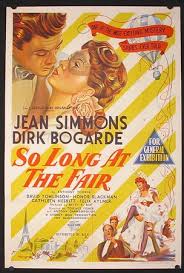
SO LONG AT THE FAIR
UK, 1950, 86 minutes, Black and white.
Jean Simmons, Dirk Bogarde, Honor Blackman, David Tomlinson, Cathleen Nesbitt, Felix Aylmer, Andre Morell.
Directed by Terence Fisher.
An entertaining British thriller of the late forties. It was a star vehicle for Jean Simmons who had recently appeared as Ophelia opposite Olivier's Hamlet. She was at the beginning of a successful career. Her leading man is Dirk Bogarde in one of his earliest films. He also was on the verge of a most successful career. Her brother is played by David Tomlinson and there is a supporting role for Honor Blackman. Direction is by Terence Fisher who was to make so many of tbe successful Hammer horror films. The setting is the Paris Fair and the disappearance of the heroine's brother. Nobody believes her and she seeks the aid of the hero to find her brother - which they do and the mystery is solved. Along the way there is tension. The period setting enhances the somewhat routine ingredients of the thriller.
1. The appeal of the mystery thriller? The clues, the solving of the mystery, suspense and tension?
2. How well did the film use its conventional material - the establishing the brother and then the disappearance of his room? The distraught heroine and nobody believing her? The hero who believes and helps her? The successful resolution? The use of period atmosphere and French setting for this material? How did it enhance it?
3. Black and white photography, the 19th century French setting, Paris and the Fair, the Eiffel Tower etc.? The atmosphere of the French hotel? The artist's garret? Special effects such as the balloon? The musical score?
4. How credible was the plot ? the tone of realism taken about the events? The contrasting atmosphere of mystery? Were sufficient clues given for the puzzle? Did the audience suspect that the heroine was not telling the truth? Was she always seen as fictive?
5. Jean Simmons' performance as Victoria? The arrival in Paris, her devotion to her brother, her exhilaration at the outings? The visits to the restaurants, the Moulin Rouge? Her looking forward to the Fair? The discovery of her brother's disappearance, her puzzle, the confrontation of the hotel owner and her brother? The growing desperation? The visit to the British Consul and his benign disbelief? Her dismay when the maid was killed in the balloon crash? her desperate going to the French police, their visit to the hotel? her reaction to the proprietress having covered every opening? The attendant and his disavowal of her brother's presence? her desperation, her agreeing to go on the train? The discovery of the letter, her reliance on George? The masked ball and the discovery of the room? The confrontation and the police? The doctor and the discovery of the truth about John? The happy ending and the prospect of romance? Popular material but a credible heroine for this kind of thriller?
6. Dirk Bogarde’s suave and pleasant style as hero - doing conventional things. his painting, his not proposing to Rhoda, his helping Victoria, his heroics in discovering the room?
7. John and his presence in Paris, looking forward to the Fairy the indications that he was not well, his disappearance and the discovery of the plague?
8. The proprietress of the hotel? her proper manner, sinister behaviour, covering every question? her mistakes in reference to the rooms? Her answers to the police? The final confrontation and her confession of the truth? Her brother and his shadowing of Victoria?
9. The O'Donovans and the sub-plot of romance with George? Rhoda and her instrumentality in bringing the note?
10. The build-up of suspense in presenting Victoria and her being distraught, nobody believing her, desperation, her almost missing the note? The relief in finding someone to help her? her dismay at discovering the truth?
11. The theme of plague in Paris during the Fair and the way that the hotel owners handled it? The doctor, the visit to the hospital and the discovery of the truth?
12. The perennial appeal of this kind of thriller? Audience interest and identification of feelings and concern? The need for a happy ending?
Published in Movie Reviews
Published in
Movie Reviews
Tagged under
Saturday, 18 September 2021 19:42
So Evil My Love
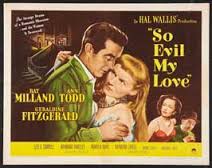
SO EVIL MY LOVE
UK/US, 1948, 112 minutes, Black and white.
Ray Milland, Ann Todd, Geraldine Fitzgerald, Leo G. Carroll, Raymond Huntley, Raymont Lovell, Martita Hunt, Moira Lister, Finlay Currie, Hugh Griffith.
Directed by Lewis Allen.
So Evil My Love is a film about evil. It is based on a number of actual cases of murder and poisoning in the United Kingdom at the end of the 19th century and the beginning of the 20th.
This fiction is very strong on atmosphere. Ann Todd portrays the widow of a missionary returning to England by boat where she meets a charming man in the form of Ray Milland. When they get back to England, she is so in love with Milland and under his control that he involves her in plans for theft. There is a death, a trial – and the woman finally realising how she has been used and turning on her evil mentor.
Ray Milland had just won the Oscar for The Lost Weekend and gives a charmingly sinister performance. Ann Todd was in Hitchcock’s The Paradine Case in the previous year but had most of her success in films in England. The supporting cast is very strong with excellent leads from Geraldine Fitzgerald and Martita Hunt.
Lewis Allen was a prolific director of brief films and television material – although he had some success with the atmospheric The Uninvited as well as the Frank Sinatra western, Suddenly and the thriller Illegal.
1. The interest and appeal of this kind of films crime, romance, melodrama?
2. The significance of the title and its irony and its themes? In a film of the forties, with its sets, style, black and white photography? The impact now?
3. The dramatic staucture of the films the meeting of Olivia and the scoundrel, her initial selfishness and capacity for nobility, the weaving of the web and her being a victim, her downfall, deaths? Audience involvement and suspense?
4. The film's focus on Olivia? First meeting her, her weakness and selfishness, her second noble instincts, a widow and her prospects? The narration of her background - at school and her feeling deprived, her wanting to be an adventuress? Her opportunity and the way that she lived it?
5. The irony ot her saving a scoundrel's life? Fascination with him, victim of his contriving, meeting and falling in love, involvement, her believing in him? Overcoming a repulsion for hie plans? Could she have helped herself?
6. What kind of villain was Mark? In himself, his artistic background, his schemes and frauds, his girlftlends and his duplicity? Using and compromising Olivia in the boarding house? Siezing opportunities, for example with Susan's letters and playing emotionally on Olivia? His dominance of her?
7. The evil of the plan and Olivia’s succumbing to it? Their expertise, Olivia’s talent commending itself even to Susan’s husband? The nature of the evil and its exercise over Susan and her husband?
8. The portrayal of Susan as sympathetic? A weak woman, dominated by a cold husband, dominant mother-in-law, manness and position in society and parliament? Her being confined, drinlging, humiliated? Her gullible nature, yet good natured? Allowing herself to be used? Wishing her husband dead, the dramatics of his heart attacks? The inevitibility of her believing herself his murderer?
9. The growth of the plot, the gaining of the money, the blackmail techniques? Yet open to error and the investigator's following Mark and Olivia?
10. What had happened to Olivia when she was in so deep? Her capacity for love, for murder? Letting Susan hang? The contrast and clash of conscience and callousness?
11. Her being hurt by the truth? The inevitability of her killing Mark? What had happened to her? The investigator’s tribute to her?
12. How good a study of a complex character and complex motivations? Man and woman and their combination for evil?
13. The contribution of the minor characters, for example the husband, his mother, the investigator?
14. The value of this film as entertaining melodrama? Study of human nature? A mirror up to the audience’s own evil inclinations?
Published in Movie Reviews
Published in
Movie Reviews
Tagged under